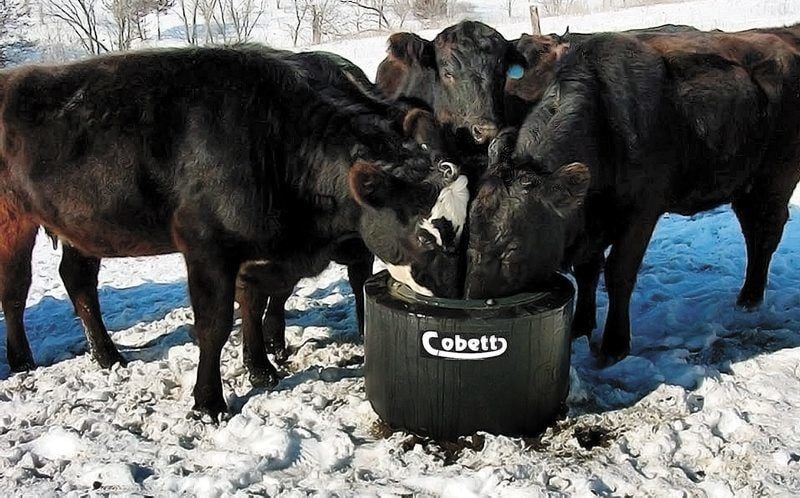Are you concerned about your cattle’s hydration? Do you want to make sure that they always have access to water but don’t have the time to constantly monitor it?
This complete guide on automatic waterers for cattle will show you how these innovative solutions can keep your livestock healthy and hydrated. You’ll learn how the technology works, why it’s important, and what you need to consider when installing one. Get ready to discover a smarter way of keeping your cattle hydrated!
The primary goal of any cattle operation is to ensure the health and well-being of the animals. This includes providing them with access to fresh and clean drinking water, which is essential for their life-long growth, health, and productivity. Automatic waterers are the most convenient and cost-effective way to manage this important task.
Automatic waterers offer many benefits including providing a reliable source of water that eliminates contamination or spoilage due to evaporation or infestation. They also reduce labor costs, reduce watering time, increase feed conversion efficiency and promote better cattle health by ensuring cows have access to clean water all day long.
This guide explores what automatic waterers are, how they work, the different types available on the market today, as well as advice on installation and maintenance. Ultimately this guide aims to inform cattle owners about why automatic waterers are a cost-effective landscaping solution that can improve herd health while decreasing labor costs associated with manual watering systems.
Explanation of wood chippers for small farms
Wood chippers are a necessary tool on many small farms. They are typically used to break down wood and other debris into manageable size pieces so they can be safely removed and disposed of. The process of chipping wood can be accomplished manually with an axe and a wedge or more quickly with the power of rubber belted hydraulically powered shredders. These machines use large flywheels to shred material like logs, branches, stumps, firewood, brush and yard waste in no time at all.
A reliable wood chipper offers an efficient way to meet the demands of daily farming tasks such as removing dead trees, dismembering fallen limbs in cropping areas or disposal of poisoned or damaged buildings materials due to severe weather or pest infestation. Choose from a variety of manufacturers who offer electric and gas-powered solutions for light-duty work or larger units that are used commercially for heavier jobs. No matter what your needs may be when it comes to managing debris on any size farm, you’ll most likely find the perfect solution with this selection available on the market today.

Importance of wood chippers for small farms
Wood chippers are an essential tool for small farms keeping cattle hydrated. This is because they offer several advantages that make the job of keeping the water clean and fresh much more efficient.
The most important of these advantages lies in their ability to easily dispose of debris, including branches and twigs that can get sucked into the cattle’s water tank and contaminate it. Wood chippers have large hoppers, which allow them to quickly chop up and dispose of any organic matter that could lead to contamination. This is especially useful for small farms with limited space, since disposing of large branches manually can take up a lot of time and energy.
Furthermore, wood chippers are also great for reducing maintenance costs. As a result of the quicker disposal times and higher efficiency associated with wood chippers, maintenance tasks such as cleaning or replacing parts in the hydration system will be much less frequent. In fact, many wood chipper models come with an automatic shut-off switch, which eliminates the risk of overheating or overworking the machinery due to prolonged use without a break.
By utilizing a wood chipper when managing cattle hydration on small farms, farmers can enjoy all these benefits while ensuring that their animals receive proper amounts of fresh drinking water at all times.
Overview of the complete guide
This guide provides an overview of all the information you need to understand and utilize automatic waterers – specifically designed for keeping cattle hydrated. This article will focus on the mechanics, benefits and longevity of these waterers.
We’ll cover the following topics:
- Classification – which type of waterer is best for you?
- Installation Options – understanding installation requirements for each type and where to start.
- Maintenance – How to clean and maintain your automatic waterer for optimal performance.
- Benefits – The advantages of using an automatic drinking system over manual watering methods.
- Cost Breakdown – Examining industry standards for average costs associated with certain types.
- Troubleshooting Tips – Tips for common issues associated with maintaining and utilizing automatic waterers effectively.
We hope this guide provides a comprehensive overview that is both educational and beneficial when deciding which type of automatic waterer best suits your needs!
Factors to Consider Before Buying a Wood Chipper
Choosing the right wood chipper can make all the difference in completing projects quickly and efficiently. Before making a purchase, consider numerous factors to ensure you are getting the best machine for your needs.
Size: First, think about the size of machine you will need for your project. Not all wood chippers are created equal — some will work well with large branches while others are best suited for smaller twigs and leaves.
Weight: Consider the weight of a wood chipper when making a decision. This is especially important if you will be transporting the machine frequently to different locations.
Horsepower: Another factor to consider when selecting a wood chipper is actually how much power it has under the hood — literally. Gears and motors should have enough torque power to handle heavy loads such as wetter or denser logs, branches and tree stumps.
Motor Type: Different types of motors are available when choosing a wood chipper such as gas or electric depending on your preference or need for mobility. Gas-powered motors provide greater portability since they do not require being plugged in, however electric motors tend to be more efficient at which they process material replacing less often from wear than gas-powered models do. Additionally, an electric motor does not require oil changes, replacements of air filters or refueling like gas powered models do. Both may work well for domestic purpose with small materials capacity but if you anticipate much heavier workloads an industrial grade model should be considered equipped with appropriate sized motor type according to your needs.
Type of Material to be Chipped
When selecting a material type to form automatic waterers, factors such as durability, cost-efficiency, and reliability of performance should be taken into consideration. The most common materials used to make automatic cattle waterers are:
-Concrete: A concrete automatic waterer provides maximum durability and excellent insulation in cold climates. It has the potential to last for decades with minimal maintenance required. However, it is vulnerable to cracks due to freezing temperatures and could leak if not installed properly.
-Stainless Steel: Stainless steel is an optimal choice for anti-corrosion protection and cosmetic appeal since it does not require painting or any other protective covering like other materials do. Although stainless steel waterers are less expensive than concrete ones, they may rust over time due to wear and tear from successive environmental elements in the surrounding environment.
-Polyethylene (Plastic): Polyethylene is a longterm plastic that is resistant to cracking from cold weather. It has low lifetime cost features since no painting or protective covering will be required for this material type. However, it isn’t suitable for large animals since the plastic can crack when stepped on with increased weight capacity.
-Fiberglass: Fiberglass offers superb performance with an unmatched lifespan compared to other materials used in creating automatic cattle waterers. This makes it a cost effective option due to its low lifetime cost feature; hence its popularity amongst owners of large livestock operations who want a longterm/durable water trough system solution. Fiberglass also offers relatively easy maintenance requirements with periodic cleaning requiring only detergents and mild abrasives needed for upkeep and function optimally over time with no repairs necessary as long as it fits your livestock needs properly.

Size of the Chipping Capacity
The size of chipping capacity that is required to accommodate the herd’s consumption requires careful consideration and planning. A standard size waterer will hold up to 10 gallons of water and provide ample drinking capacity for a herd of 20-25 cows or calves. Other sizes, ranging from 15 gallons to 100 gallons, are available depending on the number and size of the animals that are being provided with automatic water supply.
The larger tanks can be useful in instances where multiple groups of cattle will be using the same waterer, as it allows for optimal water-flow rate into different areas. If livestock is exhibiting a higher than average thirst due to hot temperatures or significant exercise, then multiple smaller tanks may be necessary. Depending on availability and other factors, plastic or metal options should both be considered when selecting a tank size.
Engine Power and Speed
One of the most important components to an automatic waterer is an engine that is powerful and operates quickly. An engine’s power is often measured in horsepower (HP) and speed in revolutions per minute (RPM). When considering a waterer with an engine, look for an engine that runs above 3600 RPM for maximum efficiency. Look for engines with higher HP ratings when needing faster flow speeds or dealing with more rugged terrain.
Additionally, be sure you consider multiple sources of energy as driving an electric motor with a 3-phase electricity connection or running on propane instead of gasoline can provide greater efficiency and reduced maintenance.
Portability
Portability is important if you are not planing on leaving a certain waterer in one location. Automatic waterers that are more portable may range in size but should generally include features that make them easier to move and install.
A few features to consider when purchasing portable automatic waterers are weight, handle, and mobility features. Lightweight models can easily be moved by hand, while some larger models may require an ATV or a small trailer to tow it around. On-board handles are often built into the top of the unit, allowing easy one-person setup without the need for additional tools or equipment. For ease of use, check to see if the product comes with wheels or casters for improved mobility across pastures, fields, or other open areas with uneven terrain. Hydraulic lift kits can also be installed for additional portability around hay bales or other obstacles that might prevent easy access for cattle and horses.
Maintenance Requirements
Automatic waterers can be a great asset for your livestock operation, but they are not failsafe. It is important to properly maintain your waterer to ensure that your cattle stay hydrated while preventing leaks and other water losses. Preventive maintenance should be performed regularly and troubleshooting repairs should be addressed as soon as possible. Below are some general guidelines for the routine maintenance of your automatic waterer.
1) Check water levels daily – The level of water in the tank should be adequately maintained to ensure that it will remain full enough to supply the cattle with plenty of fresh water.
2) Clean regularly – Waterers can become clogged with dirt and debris, so it is important to make sure you keep the reservoir clean and free from buildup. It is also recommended that you clean any hoses attached to the waterer at least quarterly or after any repair work.
3) Test pressure regulator – Automatic waterers should have a pressure regulator attached to regulate the amount of pressure going into the system based upon how many cows are drinking at one time. If you suspect that the pressure is too high, you should test it at least twice a year with a standard gauge or manometer and adjust as needed according to manufacturer’s specifications.
4) Inspect pumps periodically – Automatic watering systems rely on pumps to push water from one reservoir into another so it is important to inspect them every few months for leaks or corrosion and replace if necessary.
5) Replace parts when necessary – Sadly, things wear out over time so if any part needs replacing then replace it! Not doing so could lead to further breakdowns and costs down the road in lost productivity or even lost animals due heat stress if water can’t get through fast enough during peak demand periods in summer months when temperatures tend to rise abruptly.
Budget
Choosing the right waterer goes beyond deciding which type you prefer. Your budget is an important factor in selecting an automatic cattle waterer. You might have a small or large herd, and you need to decide if functioning around the clock is worth the upfront and ongoing costs. The cost of an automatic waterer can vary significantly, depending on its features and set-up requirements.
Let’s take a look at some of the common costs associated with different types of automatic waterers:
- Poly Waterers (water tank only): Acrylic tanks usually run between $200-$600; stainless steel tanks can cost between $400-$1,200+.
- Nipple Waterers: Nipple systems usually run between $250-$600 for a pre-made unit; tubing, additional hoses and valves will add to this cost. Additionally, you need a pressure tank that typically costs around $700.
- Ramp Waterers: Cost will depend largely on size requirements — anywhere from around $500 up through several thousand dollars — depending on system type and size needed.
It’s also important to keep in mind any additional costs associated with installation or set up of your chosen system, as well as estimated maintenance fees over time. Automatic cattle waterers are generally best suited for larger operations where hand watering would be too arduous or inefficient; however all farms can benefit from the convenience and cost savings associated with automating your watering needs!

Conclusion
In conclusion, the use of automatic waterers can bring many benefits to cattle operations, including stress reduction in animals, improved productivity and gains in weight, fewer water shortages and an overall lower cost of maintenance.
Automatic waterers are also more efficient than traditional troughs or ponds as a source of hydration for your herds – as long as they are maintained regularly. With proper installation and maintenance, these waterers can provide a high quality source of water for a long time without any major issues.
Additionally, it’s important to fuel your herds with adequate diet whatever the sizes and breeds. A well balanced nutrition will enable the animals body to better utilize the supplied water which leads to improved health outcomes overall.
FAQ
What do you understand by automatic waterer for cattle?
An automatic waterer for cattle is a device that provides a continuous supply of water to livestock without the need for manual refilling.
How do automatic livestock waterers work?
Automatic livestock waterers work by using a float valve system that regulates the water level in the trough. When the water level drops, the valve opens and allows fresh water to flow in.
What is the best water source for cattle?
The best water source for cattle is clean, fresh, and easily accessible water. This can be from a natural source such as a stream or well, or from a man-made source such as a trough or automatic waterer.
How do you keep an automatic waterer clean?
To keep an automatic waterer clean, it should be drained and cleaned regularly. This can be done by scrubbing the trough with a brush and using a mild detergent or bleach solution to disinfect it.
How do you increase water intake in cattle?
To increase water intake in cattle, it is important to provide clean and fresh water at all times. Adding salt or electrolytes to the water can also encourage cattle to drink more.
How do you make electrolyte water for cows?
To make electrolyte water for cows, mix one tablespoon of salt, one tablespoon of baking soda, and one tablespoon of sugar in one gallon of water.
Are automatic waterers advantageous?
Yes, automatic waterers are advantageous as they provide a continuous supply of fresh water to livestock, reduce labor costs, and prevent water waste.
Are automatic waterers good?
Yes, automatic waterers are good as they ensure that livestock always have access to clean and fresh water, which is essential for their health and well-being.
Do automatic waterers need electricity?
Yes, most automatic waterers require electricity to operate the float valve system that regulates the water level in the trough.
How does a cattle waterer work?
A cattle waterer works by using a float valve system that regulates the water level in the trough. When the water level drops, the valve opens and allows fresh water to flow in, ensuring that livestock always have access to clean and fresh water.
See Also :
- Best cattle waterer 2023
- Best tractor paint 2023
- Best chicken coop 2023
- Best wood chipper for small farm 2023
- Best chicken coops for 6 chickens 2023


